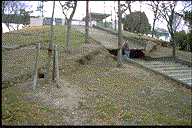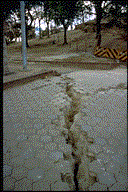3.6 Other Observations
While most of the liquefaction damage was located in Kobe and its immediate vicinity, some recent fills failed as far away as the Osaka waterfront. The Tempoyama Park (Osakako) and the Osaka Ferry Terminal are located on a man-made island in the Port of Osaka, approximately 2 kilometers south of the mouth of the Yodo River (Figure 1.1). Peak ground accelerations in this area were estimated to have been 0.2 g to 0.3 g. Liquefaction effects were observed only within a few blocks of the Osaka Ferry Terminal. The liquefaction effects consisted of sand boils, pavement separations, differential settlements, and ground fissures generally 1 to 5 centimeters wide. The most severe liquefaction effects in Tempoyama Park, a hillside park immediately to the east of the ferry building. This park contains an artificial hill, approximately 10 meters high, constructed near the edge of the island. This park was beautified with trees, walkways, and picnic areas. Liquefaction of the fill beneath the man-made hill and adjacent fill caused lateral spreading in several directions, manifested by fissures and sand boils (Figures 3. 73 and Figure 3.74).
 Figure 3.73: Fissure indicative of liquefaction and lateral spread in Tempoyama Park (Osakako) which is located on a small artificial island near the ferry terminal at the port of Osaka.
Figure 3.73: Fissure indicative of liquefaction and lateral spread in Tempoyama Park (Osakako) which is located on a small artificial island near the ferry terminal at the port of Osaka.
 Figure 3.74: Fissures in Tempoyama Park indicative of liquefaction, differential ground settlement, and lateral spread.
Figure 3.74: Fissures in Tempoyama Park indicative of liquefaction, differential ground settlement, and lateral spread.
![]() Figure 3.73: Fissure indicative of liquefaction and lateral spread in Tempoyama Park (Osakako) which is located on a small artificial island near the ferry terminal at the port of Osaka.
Figure 3.73: Fissure indicative of liquefaction and lateral spread in Tempoyama Park (Osakako) which is located on a small artificial island near the ferry terminal at the port of Osaka.![]() Figure 3.74: Fissures in Tempoyama Park indicative of liquefaction, differential ground settlement, and lateral spread.
Figure 3.74: Fissures in Tempoyama Park indicative of liquefaction, differential ground settlement, and lateral spread.